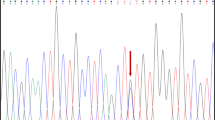Abstract
Purpose
Recently, genetic markers within a locus on 7q21.11 containing the SEMA3A, SEMA3C, and SEMA3D genes were reported to be associated with Hirschsprung disease (HSCR). Here, we investigated three polymorphisms, rs1583147, rs12707682, and rs11766001, at this locus to determine their potential contributions to the susceptibility of Indonesian HSCR patients.
Methods
Three variants were analyzed in 60 non-syndromic HSCR patients and 118 ethnicity-matched controls for association studies by genotyping.
Results
The risk allele frequencies of SEMA3 rs12707682 (allele C) and rs1583147 (allele T) is higher in cases, 53 and 23 %, than in controls, at 42 and 13 %, respectively. However, these frequency differences were not statistically significant with p value of 0.06 and 0.023, respectively. These findings were consistent with transmission disequilibrium test results with p values of 0.041 and 0.11 for rs12707682 and rs1583147, respectively. Furthermore, the frequencies of SEMA3 rs11766001 risk allele in HSCR cases and controls were 1.7 and 0.8 %, respectively.
Conclusions
SEMA3 rs12707682 and rs1583147 variants are not common risk factors for HSCR in Indonesia. The rarity of the SEMA3 rs11766001 polymorphism in Indonesian population might be due to a founder effect.
Similar content being viewed by others
References
Chakravarti A, Lyonnet S (2001) Hirschsprung disease. In: Scriver CR, Beaudet AL, Valle D, Sly WS, Childs B, Kinzler K, Vogelstein B (eds) The metabolic and molecular bases of inherited disease, 8th edn. McGraw-Hill, New York, pp 6231–6255
Amiel J, Sproat-Emison E, Garcia-Barcelo M et al (2008) Hirschsprung disease, associated syndromes and genetics: a review. J Med Genet 45:1–14
Alves MM, Sribudiani Y, Brouwer RW et al (2013) Contribution of rare and common variants determine complex diseases-Hirschsprung disease as a model. Dev Biol 382:320–329
Kapoor A, Jiang Q, Chatterjee S et al (2015) Population variation in total genetic risk of Hirschsprung disease from common RET, SEMA3 and NRG1 susceptibility polymorphisms. Hum Mol Genet 24:2997–3003
Emison ES, Garcia-Barcelo M, Grice EA et al (2010) Differential contributions of rare and common, coding and noncoding Ret mutations to multifactorial Hirschsprung disease liability. Am J Hum Genet 87:60–74
Gunadi, Kapoor A, Ling AY et al (2014) Effects of RET and NRG1 polymorphisms in Indonesian patients with Hirschsprung disease. J Pediatr Surg 49:1614–1618
Gunadi, Dwihantoro A, Iskandar K et al (2016) Accuracy of PCR-RFLP for RET rs2435357 genotyping as Hirschsprung risk. J Surg Res 203:91–94
Genomes Project Consortium, Abecasis GR, Altshuler D et al (2010) A map of human genome variation from population-scale sequencing. Nature 467:1061–1073
Cahyono JA, Sadewa AH, Tasmini (2011) Aldose reductase genetic polymorphism is a risk factor of diabetics retinopathy among type 2 diabetes mellitus in Yogyakarta, Indonesia. J Med Sci 43:57–63
Li CC (1961) Human genetics: principles and methods. McGraw Hill Book Co., New York
Spielman RS, McGinnis RE, Ewens WJ (1993) Transmission test for linkage disequilibrium: the insulin gene region and insulin-dependent diabetes mellitus (IDDM). Am J Hum Genet 52:506–516
Purcell S, Neale B, Todd-Brown K et al (2007) PLINK: a tool set for whole-genome association and population-based linkage analyses. Am J Hum Genet 81:559–575
Zivelin A, Griffin JH, Xu X et al (1997) A single genetic origin for a common caucasian risk factor for venous thrombosis. Blood 89:397–402
Rosendaal FR, Doggen CJM, Zivelin A et al (1998) Geographic distribution of the 20210 G to A F2 variant. Thromb Haemost 79:706–708
Makhmudi A, Sadewa AH, Aryandono T et al (2015) Effects of MTHFR c.677C>T, F2 c.20210G>A and F5 Leiden polymorphisms in gastroschisis. J Invest Surg 29:88–92
Jiang Q, Arnold S, Heanue T et al (2015) Functional loss of semaphorin 3C and/or semaphorin 3D and their epistatic interaction with ret are critical to Hirschsprung disease liability. Am J Hum Genet 96:581–596
Garcia-Barcelo MM, Tang CS, Ngan ES et al (2009) Genome-wide association study identifies NRG1 as a susceptibility locus for Hirschsprung’s disease. Proc Natl Acad Sci USA 106:2694–2699
Phusantisampan T, Sangkhathat S, Phongdara A et al (2012) Association of genetic polymorphisms in the RET protooncogene and NRG1 with Hirschsprung disease in Thai patients. J Hum Genet 57:286–293
Luzon-Toro B, Torroglosa A, Nunez-Torres R et al (2012) Comprehensive analysis of NRG1 common and rare variants in hirschsprung patients. PLoS One 7:e36524
Acknowledgments
We thank the patients and their families who have contributed in these studies. We also thank Prof. Aravinda Chakravarti (Johns Hopkins University, School of Medicine) for critically reading the manuscript and his suggestions. We are also grateful to the numerous nurses (Dr. Sardjito Hospital), Sri Fatmawati (Faculty of Medicine, UGM), and Maria X. Sosa (Johns Hopkins University, School of Medicine) for technical assistance, Courtney Berrios (Johns Hopkins University, School of Medicine) and Harini Natalia (Faculty of Medicine, UGM) for IRB management. The genotyping analyses reported here were performed at the Center for Complex Disease Genomics, Johns Hopkins University School of Medicine, Baltimore, MD, USA. This work was supported by the grant from DIKTI-FULBRIGHT Senior Research Program (2012) (G.).
Author information
Authors and Affiliations
Corresponding author
Ethics declarations
Conflict of interest
The authors declare that they have no conflicts of interest.
Ethical approval
All procedures performed in studies involving human participants were in accordance with the ethical standards of the institutional and/or national research committee and with the 1964 Helsinki declaration and its later amendments or comparable ethical standards.
Rights and permissions
About this article
Cite this article
Gunadi, Makhmudi, A., Agustriani, N. et al. Effects of SEMA3 polymorphisms in Hirschsprung disease patients. Pediatr Surg Int 32, 1025–1028 (2016). https://doi.org/10.1007/s00383-016-3953-7
Accepted:
Published:
Issue Date:
DOI: https://doi.org/10.1007/s00383-016-3953-7




